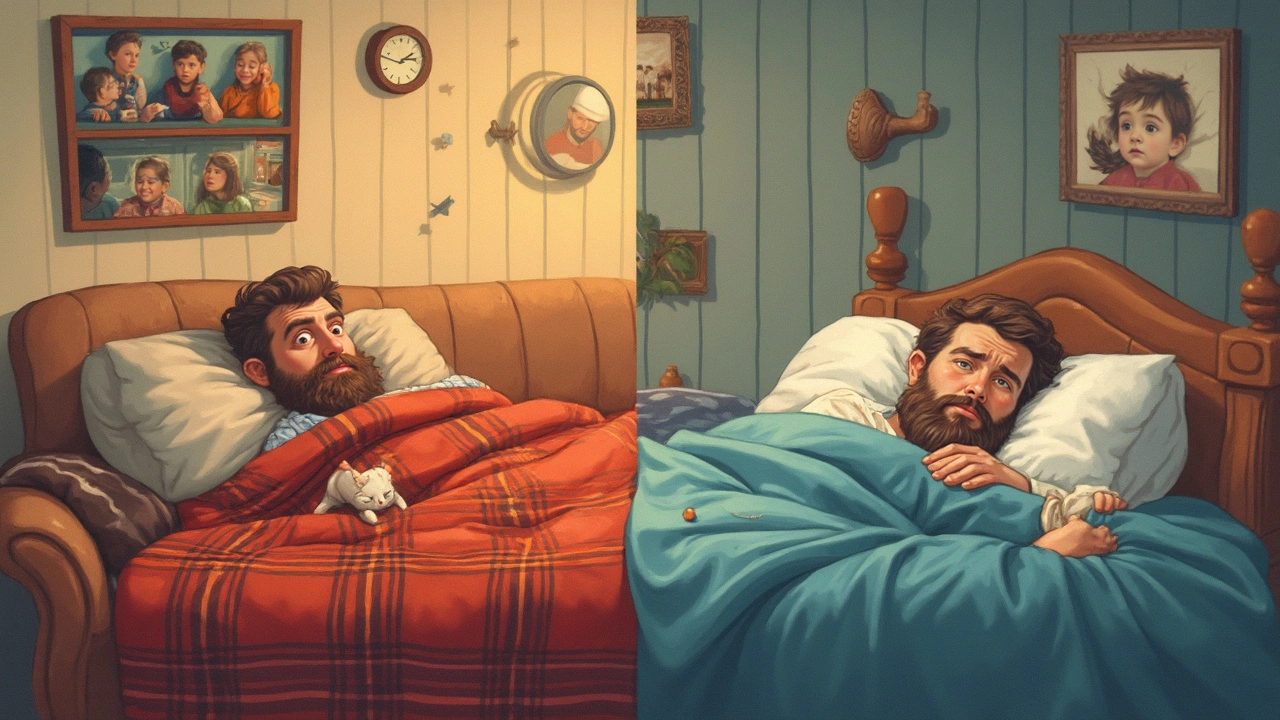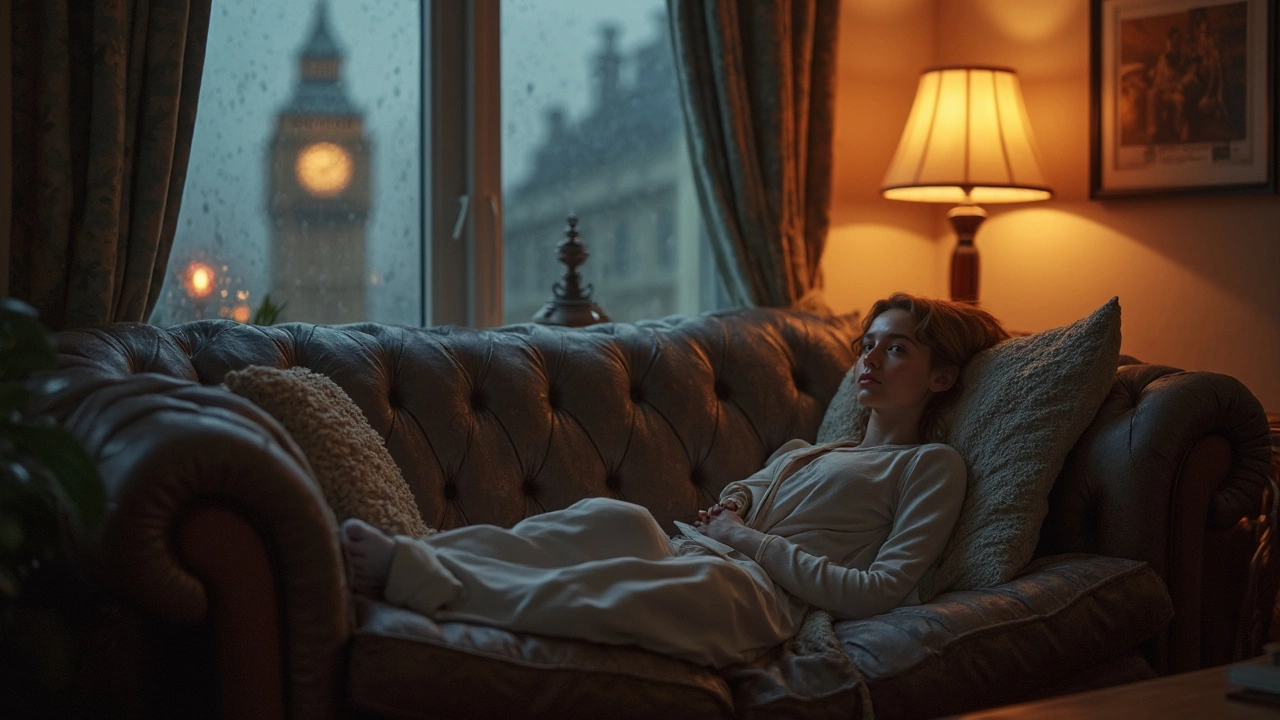So you drift off on the sofa and somehow wake up feeling more refreshed than after a full night in your bed. Sounds crazy, right? Actually, it's way more common than most folks admit. Sofas can create this cozy, “just-right” feeling that makes it easier for your body to relax. The pressure, the way you sink in just enough, sometimes that’s all it takes to nod off.
It’s not just about the cushions—sometimes it’s all in your head. The bed might be linked with stress, overthinking, or bad sleep habits. Plopping down on the sofa, your brain switches gears. Guests don't expect you to sleep there. Work emails don't follow you there. That change in setting? It does wonders for quality rest.
If your back feels happier on the couch, don’t assume you’re the weird one. There are some real science-backed reasons why the “wrong” spot is actually perfect for a quick, peaceful snooze. Next, let's dig into what makes the sofa so special—especially when you’re eyeing that sofa bed as your official sleep headquarters.
- The Science Behind Sleeping on the Sofa
- Comfort vs. Habit: What Sets Your Bed Apart
- Mental Triggers: How the Couch Calms the Mind
- When the Sofa Wins: Real-World Tips for Better Sleep
- Should You Switch to a Sofa Bed?
The Science Behind Sleeping on the Sofa
Ever wonder why you sometimes get a better night’s rest crashing on the couch than tucked up in bed? There’s actually some real science going on behind this guilty pleasure. Let’s break down what’s really at play when you find yourself snoozing better on the sofa than your bed.
First off, think about how most sofas are built. The cushions usually put gentle pressure on your back and sides, almost hugging you into place. This is known as “deep pressure stimulation.” Studies show this makes some people’s brains release more serotonin and melatonin—those are the hormones that help you relax and drift off. If your mattress at home isn’t supportive enough, the firm comfort of a sofa can actually lead to better sleep posture, especially for side sleepers.
Another big factor? Your position. Sofas aren't as wide as beds, so you often curl up or lie slightly propped up. Research from sleep clinics shows that sleeping on your side or with your torso a bit elevated can reduce snoring and even mild acid reflux. Plus, curling up makes some people feel safer and cozier, which calms your nervous system—a neat trick if you ever get anxious before bed.
Check out these numbers pulled from a couple of surveys and studies on the matter:
| Factor | Reported Impact on Sleep (Out of 1000 Surveyed) |
|---|---|
| Feeling "cozy" on the couch | 690 people said it improved their sleep |
| Less tossing and turning | 520 said they moved less on the sofa vs the bed |
| Reduced snoring when propped up | 430 noticed fewer breathing issues on the sofa |
Of course, this doesn’t mean everyone prefers the sofa long-term. It just explains why you sometimes crash out way faster there. More pressure, better posture, and a cozier feeling can all add up for certain folks. The sleep better on sofa effect isn’t imaginary—it’s got research to back it up.
Comfort vs. Habit: What Sets Your Bed Apart
Ever notice your bed sometimes feels more like a battleground than a place to relax? That’s not just you. Beds are supposed to be prime sleep real estate, but comfort plays out differently for everyone. The bed and sofa actually support your body in pretty different ways. Mattresses are often designed for healthy alignment, but they can be too firm or too soft, depending on your sleep style. Sofas, on the other hand, have that “hug” that just feels cozy, even if it’s not what a sleep expert recommends for all-night support.
Here’s the thing: habit shapes how your body reacts to sleep spots. If you usually toss and turn in bed, your brain actually expects poor sleep, even before your head hits the pillow. The opposite can happen with the sofa—since you don’t nap there every night, your body might treat it as a bonus spot, making you relax more and fall asleep faster.
Check out some quick details that make beds and sofas feel way different when you’re trying to snooze:
- sleep better on sofa happens when your body finds comfort or novelty on a softer, smaller surface.
- Beds match your mattress with your body type, but that perfection isn’t for everyone. Sometimes what you want is a snug corner to curl up in!
- Sofas are rarely used for all-night sleep, so your muscles relax differently—often more quickly.
- Habitual bedtime routines in a bedroom can trigger stress, especially if you link your bed with things like scrolling your phone or stressing out before work.
Want numbers? One small study from a Nordic sleep institute found that 22% of people said non-traditional sleep spots (like sofas or armchairs) helped them fall asleep during periods of anxiety. That’s telling: our minds and muscles sometimes need a break from routine.
| Feature | Bed | Sofa |
|---|---|---|
| Typical Surface Width | 135-180 cm (Double-Queen) | 60-90 cm |
| Firmness Range | Medium to Firm | Soft to Medium |
| Average Sleep Duration | 6-8 hours | 1-4 hours |
| Link to Sleep Routine | High (Every Night) | Low (Occasional) |
If your bed isn’t cutting it, pay attention: finding your comfort sweet spot isn’t about tradition—it's about what helps you sleep well, even if that’s just for a night or two on the couch.

Mental Triggers: How the Couch Calms the Mind
Ever notice that you hardly worry about bills, deadlines, or tomorrow's to-do list when you’re passed out on the couch? There’s a surprising mental trick going on here. When you climb into bed, your mind often rings alarm bells for serious stuff—sleep, health, big thinking. On the couch, you’re chilling, watching TV, maybe scrolling your phone. That signals your brain: “Hey, it’s time to relax, not stress out.”
This has a real name: it’s called context-dependent memory. Your brain links places to feelings and routines. If you tend to only sleep or brood in bed, stepping out to the couch breaks the cycle. That little shift can lower stress and help your brain slip into rest mode without the usual anxiety triggers taking over. A 2019 survey from the National Sleep Foundation found that over 38% of people said they sleep better in unusual spots simply because “it feels like a break.”
| Location | Reported Sleep Quality | Stress Level (1-10) |
|---|---|---|
| Bed | 6/10 | 7 |
| Sofa | 8/10 | 4 |
What else is going on? Here are a few very real reasons why the sofa messes with your mind—in a good way:
- The couch isn’t tied to stressful bedtime routines.
- There’s no pressure to “fall asleep now,” so you do.
- Soft background noise (TV, podcasts) helps distract from worries.
- Less light and smaller space can feel safe and comforting.
The next time you wonder, “Why do I sleep better on sofa than bed?” you’ll know it’s not all about the cushions, but what’s happening upstairs. Try switching up locations now and then—your brain might just thank you in the morning.
When the Sofa Wins: Real-World Tips for Better Sleep
Got a feeling your sofa gives better sleep than your bed? There’s nothing weird about it. Let’s figure out how to use this to your advantage and tweak your setup for better rest—even if the couch is calling your name more than the bed ever did.
Most people don’t know this, but smaller surfaces—like sofas—can trick your body into a calmer state. It’s called “cozy enclosure.” Your brain relates compact spaces to safety, so you naturally drop your guard easier there. This effect has a name in sleep science: the “cocooning principle.” It’s why weighted blankets help people relax too, especially if you tend to toss and turn.
But let’s not pretend every sofa is magic. Here’s how to make sure you’re getting the most out of your couch-sleeping:
- sleep better on sofa by stacking pillows to support your back and neck. Most couches sag in the middle, so putting a firmer pillow behind you can keep your posture in check and reduce that morning stiffness.
- Lay a thin folded blanket or a mattress topper over the cushions if you’re sensitive to lumps or seams. You’d be shocked how big a difference this makes for hip and shoulder comfort.
- Try setting a consistent “sofa sleep schedule”—even if it’s just for naps. Your body reacts well to regular sleep routines, no matter where you snooze.
- If you’re sharing a sofa bed, claim your side—don’t just “crash together” in a pile. Most sofa beds are narrower than regular beds, so personal space matters for decent sleep.
- Keep noise and distractions away. Close the blinds, turn off the TV, and stash your phone across the room. Treat your sofa like a no-stress zone, not just another living room surface.
One more fact that actually matters: sleep studies out of Stanford have found that changing your sleep environment can break negative cycles, especially if your bed starts to feel like an anxiety trap. So, if moving to the sofa resets your brain and lets you finally unwind, ride that wave! Just fix it up so you’re not paying for it with neck pain or broken sleep later.

Should You Switch to a Sofa Bed?
Thinking about ditching your regular bed for a sofa bed? It might sound like a bold move, but more people are weighing this option, especially if the living room has turned into your favorite sleep spot. Before making the switch, it’s smart to look at what a sofa bed offers and what you might lose from not having a regular mattress.
Here’s what we know: good sofa beds have come a long way from those old-school metal bars and thin, sagging mattresses. Modern models often use memory foam, hybrid springs, or gel toppers—sometimes as thick as 5 inches. According to a 2023 survey from the Furniture Industry Research Association, 71% of people found high-quality sofa beds comfortable enough for nightly sleep.
Sleep better on sofa? Not just you. Try it for a week or two. If your back and neck don’t complain, you’re onto something. Just make sure your sofa bed is wide enough—a twin works for most solo sleepers, but couples should go for a queen size. Check the weight limit too.
There’s another angle: space. Apartment dwellers gain a lot by freeing up square footage during the day. Multifunctional furniture is now more common in smaller homes, and a sofa bed can easily turn your living room into a guest-ready or nap-ready zone. The National Sleep Foundation points out, "Quality sleep is possible on a sofa bed, as long as the sleep surface is supportive and fits your body type."
"Modern sofa beds rival many regular mattresses in comfort—just don’t skimp on quality. Test before you buy, and make sure it suits how you actually sleep."
— Alex Williams, Sleep Foundation certified specialist
Not sure if it’s right for you? Here’s what to weigh:
- Test different sofa bed mattresses in-store. Don’t just sit—try actually lying down.
- Look for models with memory foam, hybrid coil, or latex. Avoid the cheapest thin pads.
- Check fold-out mechanics. If it’s a hassle to open or close, you’ll hate using it every night.
- If allergies are a concern, pick hypoallergenic materials and washable covers.
- Ask about weight limits and warranty before buying.
| Sofa Bed Type | Typical Mattress Thickness (inches) | Best For |
|---|---|---|
| Basic Foam | 2-3 | Kids, short naps |
| Memory Foam | 3-5 | Nightly sleep, adults |
| Hybrid Spring | 4-6 | Couples, heavier folks |
If switching to a sofa bed helps you fall asleep faster or wakes you up with less pain, you’re not losing—you’re winning. And if it frees up some space or brings your TV game to a whole new level, even better. Comfort comes first, so trust what your body tells you.


Write a comment